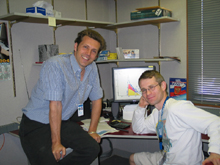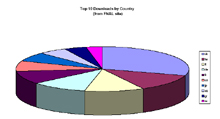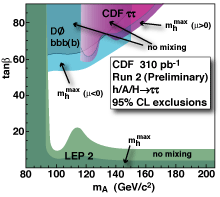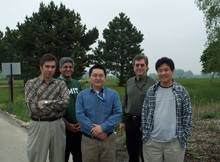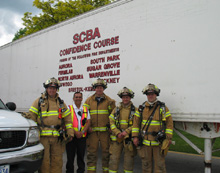 | Thursday, June 2, 2005 |
|
Thursday, June 2 2:30 p.m. Theoretical Physics Seminar - Curia II Speaker: S. Chivukula, Michigan State University Title: Higgsless Models in AdS: Lessons from Deconstruction 3:30 p.m. DIRECTOR'S COFFEE BREAK - 2nd Flr X-Over THERE WILL BE NO ACCELERATOR PHYSICS AND TECHNOLOGY SEMINAR TODAY
Friday, June 3 |
|
Extended Forecast |
Secon Level 3 |
|
Thursday, June 2 Minnesota Wild Rice with Chicken Tuna Melt on Nine Grain $4.85 BBQ Ribs $3.75 Chicken Casserole $3.75 Buffalo Chicken Wrap $4.85 Cheesey Breadsticks $2.50 Chicken Pecan Salad $4.85 The Wilson Hall Cafe now accepts Visa, Master Card, Discover and American Express at Cash Register #1.
Wilson Hall Cafe Menu |
| Fermilab Today is online at: http://www.fnal.gov/today/ Send comments and suggestions to today@fnal.gov Fermilab Today archive Fermilab Today PDF Version Fermilab Result of the Week archive Fermilab Safety Tip of the Week archive Linear Collider News archive Fermilab Today classifieds Subscribe/Unsubscribe to |
|
Scientific Linux V4 Release | ||
| ||
|
On April 20, the Scientific Linux development team, a collaboration of scientists and computer professionals from Fermilab and CERN, announced the production release of Scientific Linux v4.0. Scientific Linux is an operating system developed especially for scientific researchers.
Its developers created Scientific Linux to provide the scientific community with a supported, stable, customizable, freely available operating system designed to be compatible with the equivalent commercially-supported Linux distribution- RedHat's "Enterprise Linux." Scientific Linux, supported by the global research community, is distributed to scientists free of charge.
"We don't just take RedHat source code and repackage it," said co-lead developer Connie Sieh, a member of the Fermilab Computing Division. "We add features that are customized for the scientific community."
|
|
May 27 - June 1 - During this 144 hour period Operations established 4 stores that combined with an existing store provide the experiments with approximately 101 hours and 41 minutes of luminosity - Booster off for LCW leak and kicker spark - Store aborted due to controller problem - Debuncher Pulse Magnet replaced
Read the Current Accelerator Update |
|
From NewsForge, May 27, 2005 My Workstation OS: Scientific Linux by William Roddy Scientific Linux (SL) might seem a strange choice as a desktop operating system for someone who is retired, disabled, and elderly, and who has relatively little scientific or programming knowledge, but I get great excitement from exploring the art of Linux distributions, and with Scientific Linux, that excitement is amplified by knowing I'm using the same operating system that is being used by many of the world's leading scientists. Scientific Linux has been around for quite some time, but has made no effort to publicize itself in other than the scientific community. An announcement of upgrade on DistroWatch gained the attention of a wider community.
Scientific Linux began as Fermi Linux, at the famous Fermilab, whose mission is to explore high-energy physics, the science of matter, and space and time. Scientific Linux is a vendor-cleansed version of the latest Red Hat Enterprise Linux, completely recompiled from source. Stable versions include the 3x and 4x vendor tree and are called Scientific Linux, though they still bear the earmarks of the Fermilab craftsmanship that is a major part of it. It is completely open source, free, and available to anyone.
|
|
A Tale of Two Taus | ||
| ||
|
Often in physics quality matters as much as quantity.
This is the case with the new result from CDF in the
search for the Higgs boson, looking for its decays
to pairs of tau leptons. The tau lepton, discovered
thirty years ago, is the heaviest cousin of the
electron at 1.8 GeV in mass. One out of ten Higgs
bosons is expected to decay to pairs of taus; the
remaining nine go to b quark-antiquark pairs.
As of yet undiscovered, the Higgs particle (or particles, as in the case of supersymmetry) is thought to be responsible for imparting mass to the other Standard Model particles. Most Higgs searches tend to focus on decays to b quarks, but looking for Higgs decays to taus has advantages — we can look for the Higgs produced alone. Searches for the b decay modes require the presence of "extra" objects such as other b quark pairs produced along with the Higgs, or a W or Z boson. In the case of tau pair decays, the main background comes from decays of the Z. An analysis team from CDF uses the tau pair mass to distinguish the Higgs signal from the Z background. No signal is observed, so the team uses the result to exclude regions of the supersymmetry parameters m(A), the mass of the pseudoscalar Higgs boson, and tan beta, a parameter which governs how the Higgses give mass to up and down-type quarks and leptons. As Run II continues, the increased dataset will give CDF sensitivity to ever-lower values of tan beta, and with luck, perhaps a discovery of the Higgs boson at last! | ||
| ||
|
Result of the Week Archive |
|
Training Course Boosts
Firefighters' Confidence | ||
| ||
|
Fermilab's Fire Department met the challenge last week in the Self-Contained Breathing Apparatus (SCBA) Confidence Course, a mobile training facility for firefighters. Funded by several surrounding communities, the Course visits each firehouse twice a year to remind firefighters of conditions inside a burning building. A series of obstacles constructed in the rear of a truck simulate these conditions, which include collapsed floors and ceilings, exposed wiring and obscured visibility. FFD Acting Lieutenant Greg Hansen displayed the narrow, short passages that are filled with theatrical smoke for the exercise.
Firefighters enter the SCBA course in pairs and are equipped with the gear needed in a real fire. Brian Schopp and James Mohns explained that while the voice amplifiers, air tank and heavy suit are vital to a real fire situation, they present an additional challenge in the cramped space of the training course. Hanging wires and other obstructions are designed to snag on the firefighters' equipment, forcing them to untangle themselves and continue moving without loss of time and with limited air supply.
Even during a simulation, a strong sense of the risks involved in their
work pervades the atmosphere of ease and camaraderie that surrounds the
team. Focused on safety for each other and for the entire Fermilab community,
firefighters still joke around when time allows.
As Schopp and Mohns safely emerged from the billowing — though fake —
smoke,
team leader Neil Dal Cerro commented, "This exercise can be a lot of fun."
|
|
Register for the 2005 Fermilab Users' Meeting It's not too late to register for the 2005 Fermilab Users' Meeting. Join us for: - Presentations from representatives of DOE, NSF and OSTP, with Q&A - Latest results from Fermilab experiments - An insider's view of the EPP 2010 panel - Status of future initiatives at the lab and in HEP as a whole - Free catered dinner at the Users Center...but only if you REGISTER! Registration is free, and can be done online at the Users' Meeting Web site.
Scuba Lessons at Fermi Pool
Fermi Summer Picnic and Cougar Game - July 30 |
